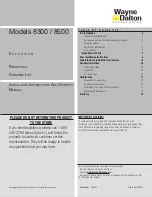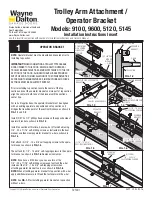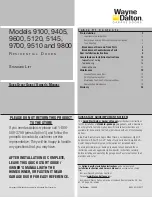
4
Gate Construction
Vehicular gates should be constructed and installed in
accordance with ASTM F2200: Standard Specification for
Automated Vehicular Gate Construction.
For a copy of the standard, contact ASTM directly at 610-
832-9585 or www.astm.org
Installation
• If you have any questions or concerns regarding the
safety of the gate operating system, do not install the
operator and consult the manufacturer.
• The condition of the gate structure itself directly affects
the reliability and safety of the gate operator.
• Only qualified personnel should install this equipment.
Failure to meet this requirement could cause severe
injury and/or death.
• The installer must provide a main power switch that
meets all applicable safety regulations.
• It is extremely unsafe to compensate for a damaged
gate by increasing he operator’s force.
• Install devices such as reversing edges and photo
beams to provide better protection for personal
property and pedestrians. Install reversing devices that
are appropriate to the gate design and application.
• Before applying electrical power, ensure that voltage
requirements of the equipment correspond to the
supply voltage. Refer to the label on your gate operator
system.
Usage
• Use this equipment only in the capacity for which it was
designed. Any use other than that stated should be
considered improper and therefore dangerous.
• The manufacturer cannot be held responsible
for damage caused by improper, erroneous or
unreasonable use.
• If a gate system component malfunctions, disconnect
the main power before attempting to repair it.
• Do not impede the movement of the gate, you may
injure yourself or damage the gate system as a result.
• This equipment may reach high thermal temperatures
during normal operation, therefore use caution when
touching the external housing of the gate operator.
• Use the manual release mechanism according to the
procedures presented in this manual.
• Before performing any cleaning or maintenance
operations, disconnect power to the equipment.
• All cleaning, maintenance or repair work must
performed by qualified personnel.
GENERAL SAFETY PRECAUTIONS
j) For gate operators that utilize a contact sensor (edge
sensor or similar):
1) One or more contact sensors shall be located where
the risk of entrapment or obstruction exists, such as at
the leading edge, trailing edge, and postmounted both
inside and outside of a vehicular horizontal slide gate.
2) One or more contact sensors shall be located at the
bottom edge of a vehicular vertical lift gate.
3) One or more contact sensors shall be located at the
pinch point of a vehicular vertical pivot gate.
4) A hardwired contact sensor shall be located and its
wiring arranged so that the communication between
the sensor and the gate operator is not subjected to
mechanical damage.
5) A wireless device such as one that transmits radio
frequency (RF) signals to the gate operator for
entrapment protection functions shall be located where
the transmission of the signals are not obstructed or
impeded by building structures, natural landscaping or
similar obstruction. A wireless device shall function under
the intended end-use conditions.
6) One or more contact sensors shall be located on the
inside and outside leading edge of a swing gate. Addi-
tionally, if the bottom edge of a swing gate is greater
than 152 mm (6 in) but less than 406 mm (16 in) above
the ground at any point in its arc of travel, one or more
contact sensors shall be located on the bottom edge.
7) One or more contact sensors shall be located at the
bottom edge of a vertical barrier (arm).





































